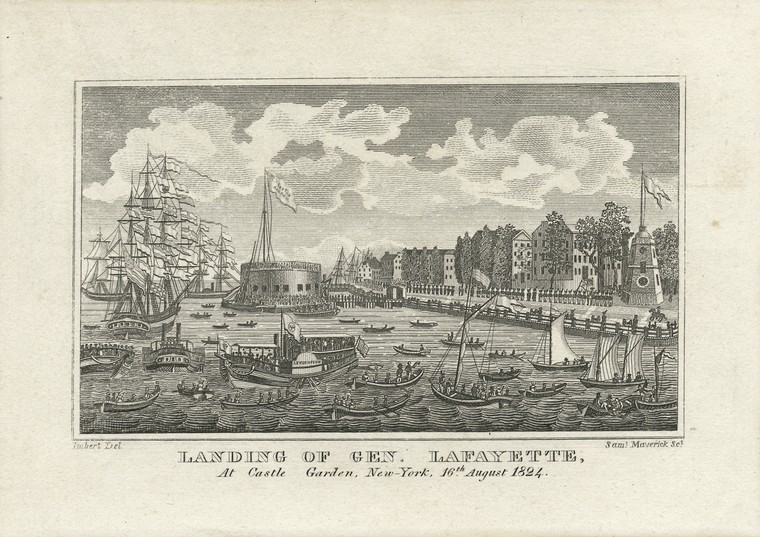bloc_article_content
Lafayette: French Hero of the American Revolution
In the United States, Lafayette remains the most beloved French hero of the American Revolution with dozens of towns, counties, parks, streets, and schools named in his honor.
Gilbert du Motier, Marquis de Lafayette (1757-1834) served as Major General in the Continental Army during the U.S. War of Independence and developed a close friendship with George Washington.
Youth
Born at the Château de Chavaniac in the Auvergne region of south-central France, Lafayette belonged to a noble family that prized military glory. When Lafayette was two years old, his father was killed by an English cannonball in the Seven Years’ War. In 1774, after the death of his mother and grandfather left him a very wealthy orphan, Lafayette was presented at court and married Adrienne de Noailles, member of an influential family.
Military Beginnings
Lafayette secured a series of appointments and promotions in the Noailles Dragoons. By the summer of 1775 he held the rank of Captain and commanded a company. During exercises in Metz that year, Lafayette learned of the American colonists’ struggle from the Duke of Gloucester, the American-friendly brother of King George III.
American Opportunities
Lafayette’s dreams of a military career was dashed in June 1776 when reforms forced Lafayette and other wealthy officers out of active duty. But new opportunities arose in July 1776 when Connecticut merchant Silas Deane reached Paris seeking support for the American insurgency. Deane was inundated by newly idle officers seeking to join the American cause. Lafayette and others in the Noailles circle were among those hoping to fight against the English – France’s age-old rivals.
Victoire
Although France remained officially neutral in the conflict, the crown looked the other way while scores of men sailed to America. Lafayette and his friends, though, were forbidden to go; they were too closely allied with court for Versailles to maintain deniability. So Lafayette bought a ship that he rechristened the Victoire. On July 28, 1777, Congress welcomed Lafayette in Philadelphia as a Major-General serving in the Continental Army without pay.
George Washington
Lafayette remembered being “in awe” when he met General George Washington at Philadelphia’s City Tavern on July 31, 1777. Washington was initially unclear about Congressional intentions for Lafayette whose rank of Major-General seemed incongruous for a nineteen-year-old with no battlefield experience. Yet Washington welcomed Lafayette into his military “family”.
Battle of Brandywine
On September 11, 1777. British General William Howe engaged with the Americans at the Brandywine River while driving south toward Philadelphia. Lafayette fought and was wounded in the leg in the American loss. Washington inaugurated Lafayette’s fame by announcing his injury in a letter published in newspapers throughout the colonies.
French-American Diplomacy
While recovering in Bethlehem, Pennsylvania, Lafayette spent his time writing letters to French and American officials praising them to each other and proposing that France attack British interests in the Caribbean and India. These plans were not adopted, but Lafayette established himself as the foremost French advocate for the American cause. In May 1778, when news of the Franco-American Treaty of Alliance and Treaty of Amity and Commerce reached America, Lafayette rightly claimed some credit.
Retreat at Barren Hill
Having been named commander of a division in December 1777, Lafayette was charged in May 1778 with determining whether the appearance of British evacuating Philadelphia was a ruse. Leading the men he had trained with at Valley Forge, as well as hundreds of Pennsylvania militiamen and forty-seven Oneida warriors, Lafayette camped for two nights at Barren Hill. On May 20, Lafayette’s detachment was set upon by five thousand British soldiers advancing from three directions. Lafayette maintained his composure and effected an orderly retreat that left only nine dead.
Hermione
Following a leave of absence from the American Army, Lafayette set sail from France once more on March 11, 1780, this time on a French naval ship—the Hermione. Lafayette was bearing good news: Louis XVI would be sending six ships of the line and six thousand infantry troops under the leadership of the comte de Rochambeau to support the American cause.
Yorktown
Lafayette spent the spring of 1781 leading his troops in a series of encounters that were part of the Americans’ successful Virginia Campaign. Lafayette kept the British General Cornwallis engaged while Washington maneuvered his troops overland and Rochambeau sailed French ships toward the Chesapeake River. At Yorktown, Virginia, Cornwallis was trapped between American forces on the north, south, and west, and French ships in the Chesapeake to the east. The British surrendered on October 17. With major hostilities over, Lafayette returned to France.
Triumphal Tour
In 1824-1825, at the invitation of President James Monroe, Lafayette toured the United States as “The Nation’s Guest.” Visiting all twenty-four states in thirteen months, Lafayette was celebrated with an outpouring of festivities the nation had never seen. During and after this visit, hundreds of towns, cities, streets, parks, and schools were named in Lafayette’s honor. He is remembered to this day as the French hero of the American Revolution.
Published in september 2020
Picture caption : A. L. Marquis de Lafayette, major général des armées des Etats-unis de l'Amérique, en pied.


